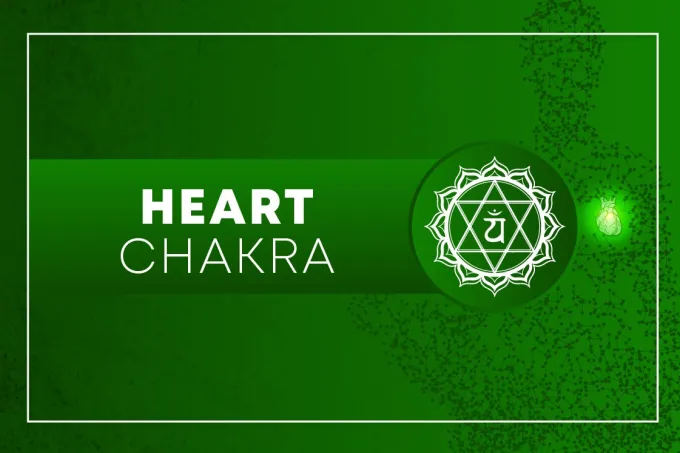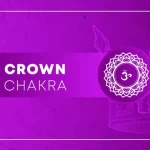The fourth of the seven primary chakras, often known as the heart chakra or Anahata chakra, is situated in the middle of the breastbone. It controls how people feel about themselves and the people in their lives, fostering forgiveness, compassion, and empathy.
The Heart Chakra at a Glance
| Sanskrit Name – Meaning | Anahata – unstruck sound |
| Location | Centre of chest |
| Color | Green |
| Seed Mantra | YAM |
| Element | Air |
| Characteristics | Harmony with nature, unconditional love, positive neutrality, harmonious relationships |
| Symptoms of blocked | Headaches, blurred vision, sinus issues, eyestrain, seizures, hearing loss, hormone function |
| Healing Crystal | Green Aventurine, Prehnite, Emerald |
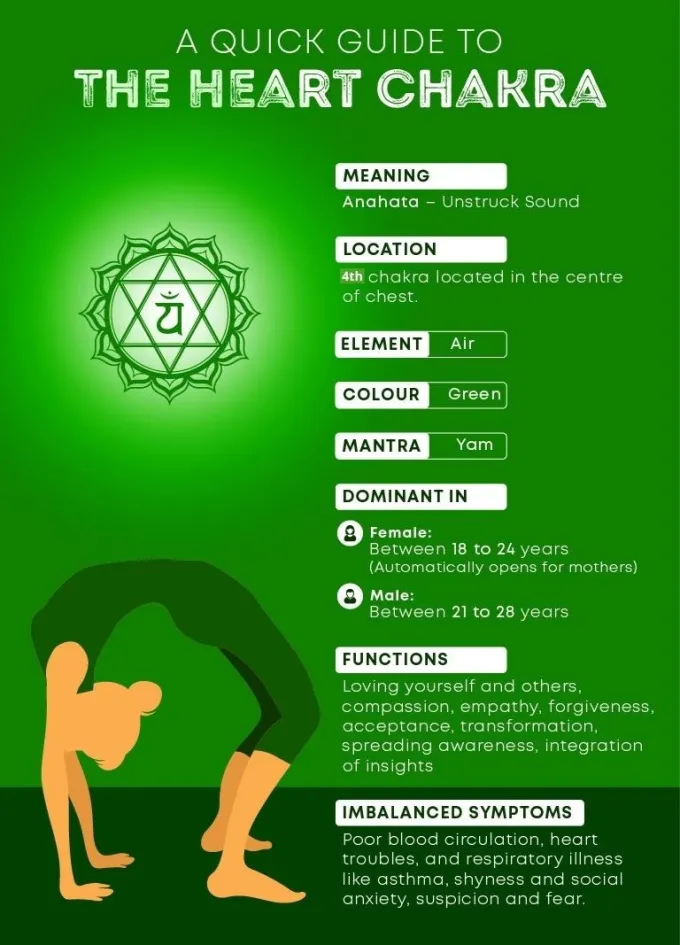
With this quote, I want to emphasize the significance of the Heart Chakra, which is the chakra of relationships and is driven by the ideas of integration and transformation.
In terms of where it is on the body, the heart chakra is the core of the chakra system and ranks fourth out of the seven main chakras. It connects the lowest three chakras (root chakra, sacral chakra, and solar plexus chakra), located at the center, with the higher three chakras (throat chakra, third eye chakra, crown chakra).
The ego (as our identity) is linked to the material world, security, external beauty, and the realm of name and reputation in the lower three chakras. In the fourth chakra, the ego expands for a higher purpose and lets us feel one with everything rather than being self-centered. It is a heart chakra quality.
The heart chakra is linked to equilibrium, tranquility, and composure. Your brain overcomes the feelings that block your heart chakra when you’re nervous or stressed, which causes both mental and physical disturbance.
By allowing consciousness to enter the heart chakra, this guide will clear up your perception of how you feel about connecting with other souls.
Anahata chakra meaning
The Sanskrit word for the heart chakra is Anahata. The phrase directly translates to “unstruck or undefeated sound,” which is the sound made when no items are struck. Typically, it conjures up images of a tranquil but unsettling sound, sometimes known as a soundless sound.
The epitome of Anahata is the sound of OM. The natural frequency of OM is thought to be existing in the universe now as it was when it was first created (when there was nothing to make sound).
The heart opens the door to higher wisdom, which is why the Anahata sound is connected to the heart chakra. It can only be heard when one is sensitive enough to hear one’s own voice, which is one of the most delicate sounds. And meditation is one of the most crucial methods for developing this capacity for listening. You can easily reach that state of meditation with the use of nada and kriya yoga techniques.
Location and associated organs
The heart chakra is situated behind and slightly to the left of your breastbone, between the front and middle of your chest (between the right and left lung). It is located at the level of the T8 thoracic vertebrae when viewed from the back.
Due to the heart chakra’s proximity to the lungs and the heart, oxygen control is important for maintaining the chakra’s equilibrium. A powerful technique to support this area of the body’s energy system is pranayama.
The upper back, including the thorax and thoracic cavity, the lower part of the lungs, skin, hands, and arms are the primary locations for this chakra. The immunological system, the respiratory system, and the cardiovascular system are all connected to this cardiac region.
Furthermore, the thymus endocrine gland, a vital component of the immune system, is controlled by the heart chakra. The thymus gland is referred to as the “higher heart chakra” and the “place of the soul.” It stands for enlightenment, unwavering love, forgiveness, and compassion.
Green color significance
It is believed that each chakra in your body is directly associated with a particular color and vibrates your body with its own frequency.
The soul is tinged with the color of its thoughts.
Green is the color of the heart chakra. Its green hue stands for youth, security, tenderness, and adaptability. It highlights the significance of new beginnings, the promise of fresh hopes, the enduring nature, and the capacity to spread love.
Morning exposure to green chakra-colored things, such as plants, causes the release of cortisol (stress hormone). It aids in waking you up early and provides you with new stimuli in the morning.
Heart chakra symbol
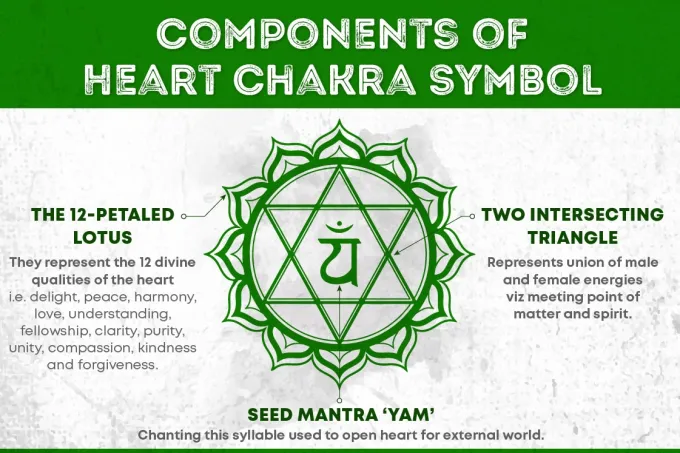
Each of the seven chakras is symbolized with a special symbol that expresses the essence and purpose of that particular chakra.
The heart chakra is represented by a circle made of twelve lotus petals encircling two intersecting triangles that come together to form a six-pointed star.
The following characteristics describe the heart chakra symbol.
- Twelve lotus petals: Twelve petals positioned in a circle depicted qualities of the heart when the chakra lies in a balanced state.
2. Animal nature: In the Hindu tradition, the deity associated with the heart chakra is Vayu (air), who sits at the center of the symbol, riding an antelope.
The animal nature here is well depicted by the black antelope. It runs around restlessly but always in joy, searching for the source of the smell of the musk that resides in its navel.
3. Triangles: The triangles represent the descent of the spirit into the body and the ascent of matter rising to meet the spirit. The heart is indeed a center of the intersection of two triangles, creating a Shatkona (6 angles), a symbol used in the Hindu Yantra.
The energy frequency and seed mantra
Each chakra radiates energy that is matched to a specific frequency and wavelength of the visible spectrum.
The heart chakra vibrates at a frequency of 639 Hz. This frequency’s sound improves mood and stabilizes emotions. When you are nervous, experiencing unpleasant feelings in your heart, or experiencing relationship issues, listening to music on this frequency can be therapeutic.
YAM is the seed mantra of the heart chakra that corresponds to a 639 Hz frequency. This “mantra” is connected to the control over the air and Prana (life force) in our body.
Vayu (air), the least dense of our physical elements up to this point, is the element of the heart chakra. It makes the Vata dosha person’s heart chakra dominant. Air is a symbol of simplicity, lightness, softness, freedom, openness, and freshness.
Characteristics of the heart chakra
The heart chakra serves as the brain stem for forgiveness, connection, empathy, and compassion. No matter if the odds are in your favor or against you, it enables you to encounter and accept any scenario in life.
Your ability to ascend above materialistic identity is determined by this chakra. Actually, it’s the mental state that occurs when you identify with your higher self.
When your heart chakra is activated, you allow yourself to be guided by the power of the higher self that many refer to as God, The Source, or Cosmic Intelligence.
I am deserving of love, says Heart Chakra in a mesmerizing voice. I kindly permit joy to permeate my body, mind, and experience. which is observable when;
1. Release Expectations
We become wounded when expectations that conform to our definitions are not met. Therefore, let go and let go of life’s expectations. Karma Yoga encourages us to put our attention on accomplishing things and then respect the results.
When you let go of expectations, love flows freely and unconditionally, causing your heart chakra to fully open.
2. Release Attachments
Desire causes agony because it causes the dread of losing. Everything that makes us happy also makes us unhappy. When we can let go of our ego, we are no longer victims of wants related to the material world.
One needs to let go of attachments, get rid of expectations, and make love divine and unconditional if one wants to progress in life.
3. Trust your Relationships
Anahata is built on the idea that relationships should be based on trust and full awareness. Everyone behaves according to their perceptions, constraints, priorities, and concerns rather than betraying anyone.
4. Forgiveness
You can only be freed by letting go of your hurt and pain and forgiving people who have wronged you, whether purposefully or unintentionally.
How to know if the heart chakra is balanced?
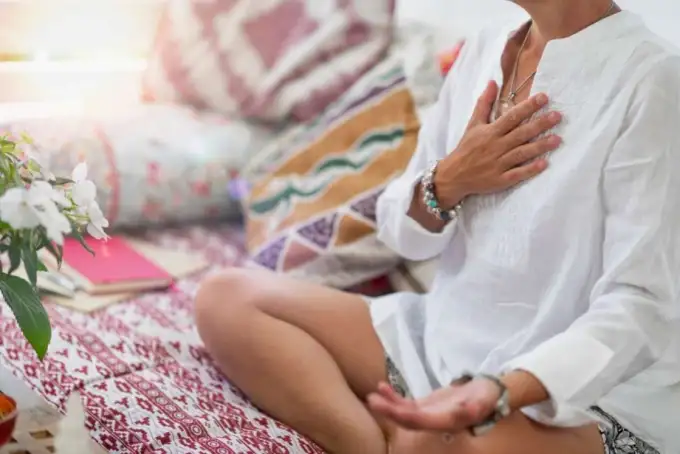
Waves of love and compassion flow through us when our heart chakra is balanced and open, making it easier for us to forgive and accept both ourselves and others easily.
By practicing unconditional love, we can release our emotional pain by balancing the Anahata chakra. The heart chakra, which serves as the point of transition between our human self and our divine self, is where the ancient texts held that our “jiva atman” (soul) resides. Our seed of inner peace and harmony can open and flourish as the heart center grows with love and compassion.
Balanced heart chakra manifests in the form of;
- Harmony with nature
- Unconditional love
- Positive neutrality
- Harmonious relationships
- Nonjudgmental of self or others
- Compassionate
- Peaceful
Imbalanced heart chakra symptoms and their causes
Grief, rage, jealousy, fear of betrayal, and hatred of oneself and others result from an unbalanced heart chakra. It causes physical symptoms like bronchitis, asthma, cardiac issues, high blood pressure, breathing difficulties, and lung infections.
Imbalanced heart chakra manifests in the form of;
- Loneliness
- Jealousy
- Bitterness
- Inability to forgive
- Passive aggression
- Inability to love
- Judgmental
- Lack of empathy
- Smothering behavior
Since the heart is essentially the core of all bodily activities, having an imbalanced heart chakra causes you to have low energy levels throughout your entire body. An imbalance in the heart chakra may be caused by the preponderance of hate and negativity. You’ll experience feelings of helplessness, shyness, rejection, and seclusion from the rest of society. Hopelessness can cause you to withdraw from others, which will result in the loss of some important connections.
The misaligned heart chakra will manifest physically as a weakened immune system (colds, flu, and recurrent infections), low/high blood pressure, poor circulation, and breathing problems.
1. Overactive heart chakra
The overactive heart chakra is a manifestation of imbalance caused by an excessive energy flow in the heart.
If the heart chakra is too open, it could show as:
- Being overly demanding, especially close family or partner
- Extending to fulfill other people’s perceived needs to the cost of one’s balance
- The tendency to feel like a victim
- Losing a sense of personal boundaries in a way that is detrimental to the well-being
Additionally, because of an overactive Anahata Chakra, we become estranged from our relationships and let our emotions and possessiveness rule us.
2. Blocked heart chakra
The blocked or underactive heart chakra is a sign of an imbalance caused by the heart’s energy being repressed.
Lack of empathy and compassion for oneself and others are symptoms of a blocked heart chakra. A person can either become too sensitive or emotionally distant.
Because we are afraid of being betrayed when Anahata is underactive, we find it difficult to love or be loved. As a result, we continue to harbor resentment, sorrow, and loss, lose faith in other people, and develop into critical, judgmental, and intolerable people.
How to balance heart chakra?
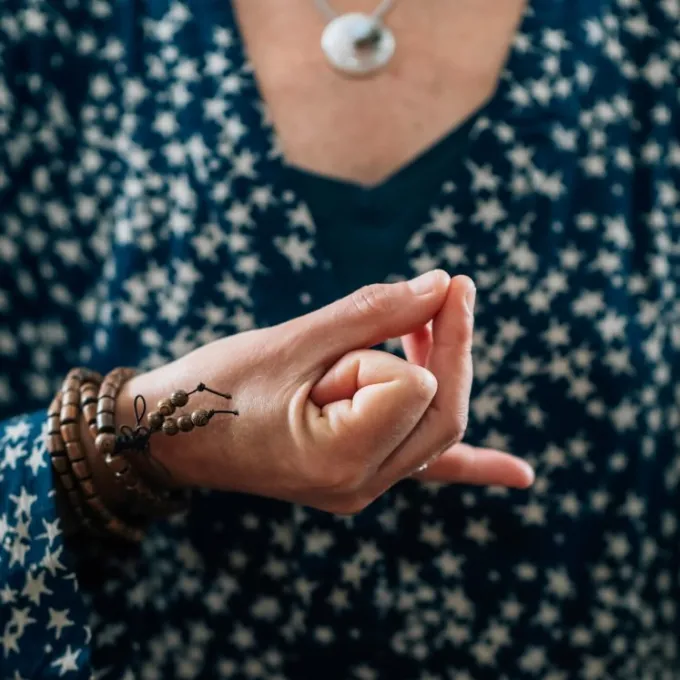
1. Incorporating karma yoga principles
Karma yoga is the path that emphasizes one to follow their duty without any attachment to the results. Incorporating the principles of karma yoga principles can help you open the heart chakra.
- Experience each moment for what it is and accept it without comparing it to times in the past or the future. Nothing is permanent, hence no moment can be sustained indefinitely.
- Let go of connection to the past – We frequently cling to individuals or situations when we feel content, secure, and at ease in their presence. Thus, moving past attachments and widening the heart and mind paves the path for a new future.
- Release the need to control the result by learning to accept the present moment as it is. Let go of the desire to know and embrace mystery. It is impossible to predict how life will turn out. Just try to enjoy today.
- Release Your Attachment to Your Emotions – Recognize that suffering is inevitable. You’ll suffer some degree of anguish and lose important items. However, it needn’t be as horrible as you imagine. According to a proverb, discomfort is unavoidable, but suffering is not.
2. Practice pranayama and heart-opening yoga poses
Yoga can assist in balancing the heart chakra and promote living with an open heart, acceptance of others and ourselves, and the release of hate and negativity.
By controlling the movement of air into and out of the lungs, pranayama practice has a direct impact on the function of the heart. These lung breathing exercises with pranayama will undoubtedly aid in keeping your heart chakra balanced and open.
To awaken your heart chakra and see the world with love, try using the following yoga poses;
- Half Camel Pose (Ardha-Ushtrasana): Half Camel Pose is a deep backbend for your upper back, and literally and metaphorically opens up your heart space.
- Wheel Pose (Urdhva Dhanurasana): Wheel Pose develops mobility and flexibility in your spine and hip flexors as well as creating space in your heart.
- Bridge Pose (Setu Bandha Sarvangasana): Bridge Pose is a gentler variation of Wheel Pose and it begins to create flexibility and strength in your spine.
- Reverse warrior pose: Warrior 1 Pose strengthens your quads while creating flexibility in your hips.
- Upward-Facing Dog Pose ( Urdhva Mukha asana): Upward-Facing Dog strengthens and tones your arms while creating flexibility in your spine.
- Bow Pose (Dhanurasana): Bow Pose generates mobility in your spine as well as flexibility in your hip flexors.
3. Practice meditation with heart chakra mudra
Meditation and mudras make a perfect combined practice to direct energy to any part of the body. All we have to do is meditate on a particular part of the body and hold hands in a specific mudra to redirect energy to that part.
The simplest method for balancing the heart chakra is to clasp hands in the Apana Vayu Mudra while focusing on your heart center. This mudra can increase blood circulation and reduce pain in the chest region.
4. Using heart chakra stones
Using crystals is one of the best ways to balance an overactive or underactive heart chakra.
The nine crystals listed below all resonate at the heart chakra’s frequency, enhancing compassion and love. They also make it possible for forgiveness and empathy to flourish, which can improve any relationship.
- Rose Quartz: Stone of Unconditional Love
- Rhodochrosite: Stone for Selfless Love and Compassionate Heart.
- Emerald: Stone of Successful Love
- Rhodonite: Stone of Self Love and Unconditional Love referred to as an emotional balancer.
- Green Aventurine (Stone of Opportunity)
- Green Jade: Dream Stone and Stone of Fidelity
- Amazonite: Stone of Hope and Courage, supports both the heart and throat chakra.
- Prehnite: Stone of Unconditional Love and Healing
5. Add heart chakra food to the diet and make lifestyle changes
Green fruits and vegetables can help you unlock your clogged heart chakra.
- Consume green vegetables such as kale, spinach, brussels sprouts, salad greens, and pot herbs.
- Use aromatherapy products such as Geranium, Sandalwood, Jasmine, and Lavender.
- Pay attention to the sound of wind instruments, such as the flute and saxophone.
- Wear 15 Mukhi Rudraksha and emerald-colored jewels.
Conclusion
You can develop into a person who is kind and caring toward others if you maintain the balance and health of your heart chakra. Giving forgiveness, love, and kindness to others is the only thing that the heart chakra can help you with; you cannot expect anything in return.
















